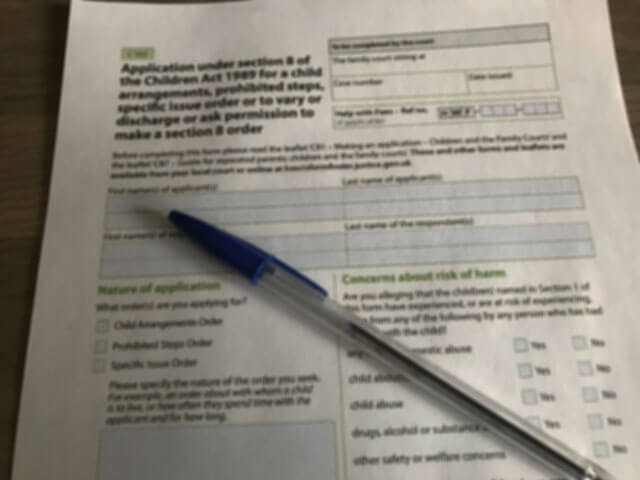If you wish to apply to the court for a child arrangements order, a prohibited steps order or a specific issue order then you will need to complete an application form known as ‘Form C100’.
The form can be a little daunting for non-lawyers, so here are some tips to help you complete it.
The first thing you need to tell the court is what order or orders you want the court to make. There are three options:
A Child Arrangements Order – An order setting out with whom the child should live, and if with only one parent, what contact the child should have with the other parent. This is the most common type of order.
A Prohibited Steps Order – An order that no step which could be taken by a parent in meeting their parental responsibility for a child, and which is of a kind specified in the order, shall be taken by any person without the consent of the court. This may be used, for example, to prevent a parent changing the child’s name.
A Specific Issue Order – An order giving directions for the purpose of determining a specific question which has arisen, or which may arise, in connection with any aspect of parental responsibility for a child, such as which school the child should attend.
You need to tell the court whether you need its permission to make the application. Parents do not need permission but others, including grandparents, do.
Perhaps the most important section of the form is where you tell the court your reasons for making the application.
There may be many things that you would like to say about the other parent of your child, but before you say anything you should ask yourself: is this actually relevant to the issue between yourself and the other parent? The court will not want its precious time wasted on matters that are not relevant.
So what is relevant? Well to give you an idea, there is a list of factors that the court must take into account when deciding whether to make an order relating to a child. These include the ascertainable wishes of the child, the child’s needs, the effect on the child of any change in their circumstances, any harm that they have suffered or are at risk of suffering, and how capable the parents are of meeting the child’s needs.
If you have previously prepared a parenting plan (a written plan worked out between the parents after they separate, covering the practical issues of parenting), this should be sent to the court with the form.
Lastly, you need to tell the court whether the application is urgent, and if so, why. Urgent applications can be heard by the court at short notice and even without informing the other party, although any order made by the court will usually only be temporary.
* * *
Family Law Cafe’s accessible team of legal experts from various disciplines expedites the customer’s case and keeps them informed and in control 24/7 through a unique and secure online portal. Family Law Cafe is your start-point for getting matters sorted with strategy, support and security.
Image: Family Law Cafe

